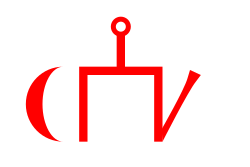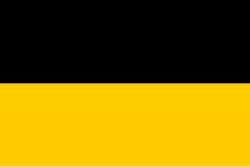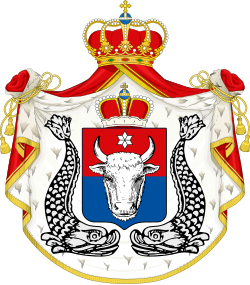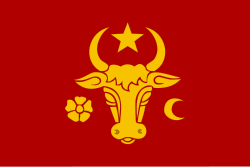Moldavské knížectví
| Moldavské knížectví Țara Moldovei Цара Молдовей
| |||||||||||||
Geografie
| |||||||||||||
| Obyvatelstvo | |||||||||||||
| Státní útvar | |||||||||||||
volená absolutní monarchie s dědičnou panovnickou linií | |||||||||||||
Vznik | |||||||||||||
Zánik | 1859 – spojení s Valašskem | ||||||||||||
| Státní útvary a území | |||||||||||||
| |||||||||||||
Moldavské knížectví nebo také vojvodství (rumunsky Țara Moldovei, staroslověnsky Землѧ Молдавскаѧ[6][7][8][9]), zkráceně Moldávie, bylo polonezávislé knížectví a léno Polského království, poté vazalský stát Osmanské říše a později protektorát Ruska. Bylo založeno v polovině 14. století.
Historie
Prvním vládcem se stal Bohdan I., který se roku 1359 zbavil uherského vlivu a stal se tak prvním nezávislým knížetem.

Později se Moldavsko dostalo do lenní závislosti na polském státě. Nejvýznamnějším moldavským vládcem byl kníže Štěpán III. Veliký (1457–1504). Za jeho vlády bylo knížectví ohroženo agresí sousedního Polska, Uherska, ale především Osmanské říše. Proti ní se Stefan snažil vytvořit alianci. Roku 1489 byl nakonec Turky donucen platit tribut a jeho nástupce později uznal lenní závislost země na Osmanské říši.
Již v roce 1769 po postupných porážkach obsadila severní území Moldavského knížectví (Bukovina) vojska carského Ruska a v roce 1774 Habsburské monarchie. K ní pak bylo území jako vévodství Bukovina v roce 1775 podle Konstantinopolské dohody připojeno.
Východní část knížectví Moldávie východně od řeky Prut byla roku 1792 připojena k Rusku jako Besarábie (roku 1918 se stala součástí Rumunska). Zbylá část knížectví (ležící západně od řeky Prut) roku 1829 získala od Osmanské říše samosprávu.
Mezi lety 1769 a 1854 bylo několikrát okupováno Ruským impériem. Od roku 1859 mělo společného knížete se sousedním s Valašským knížectvím s nímž se v roce 1862 sjednotilo, čímž vznikla Spojená knížectví Valašska a Moldávie, předchůdce dnešního Rumunska.
Geografie
- Moldavské knížectví v roce 1483 za vlády Štěpána III. Velikého
- Moldavské knížectví (oranžová) v letech 1793–1812
- Moldavské knížectví v roce 1812
- Moldavské knížectví (oranžová) po roce 1856
Symbolika
Vlajky, korouhve



| podoba | období | popis |
|---|---|---|
| 1467 | korouhev (rekonstrukce) z bitvy u Baie | |
| 1531 | korouhev (rekonstrukce) z bitvy u Obertinu | |
 | 14.–15. stol. [zdroj?] | knížecí prapor (rekonstrukce) |
  | 1574 | prapor zaznamenaný A. Guagninim |
 | 1601 | |
 | 17. století | zaznamenán u oddílu moldavského jezdectva |
 | 1834 | vojenský prapor moldavského oddílu pěchoty |
 | 1831–1859 | obchodní vlajka, jako státní potvrzená Pařížskou dohodou v roce 1858 |
 | 1834–1861 | obchodní vlajka |
Znak
| podoba | popis | podoba | popis | podoba | popis |
|---|---|---|---|---|---|
 | pečeť Štěpána III. Velikého (1457–1504) |  | rekonstrukce znaku Štěpána III. (1457–1504) |  | znak v roce 1586 |
 | znak za vlády Árona Tyrana (1591–1592, 1592–1595) |  | znak v roce 1643 |  | historický znak Moldávie 1806–1807 |
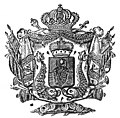 | státní znak v roce 1855 (vyobrazení z cestovního pasu) |  | reprodukce státního znaku podle cestovního pasu |  | malý znak z vojenského praporu z roku 1849 |
Odkazy
Reference
- ↑ Dimitrie Cantemir Descriptio Moldaviae
- ↑ Pierre Lescalopier l’an 1574 de Venise a Constantinople, dans Paul Cernovodeanu, Studii și materiale de istorie medievală, IV, 1960, p. 444
- ↑ Paul Cernovodeanu, Studii și materiale de istorie medievală, IV, 1960, p. 444.
- ↑ Камбур Дмитрий Представительство русского населения Молдавии в Боярском совете при Петре Рареше (1527-1538, 1541-1546 гг.)
- ↑ Суляк С. Г. Русский язык в Молдавии // Русин, 2010
- ↑ File:Seal of 1392. Roman I of Moldavia.jpg
- ↑ File:Seal of Stephen III of Moldavia.svg
- ↑ File:Sigiliul lui Ștefăniță Vodă 1518.jpg
- ↑ File:Sigiliul lui Petru Rareș 1533 (Siegel des Petru Rareș 1533).jpg
Související články
- Moldávie
- Seznam moldavských knížat
- Kostely v Moldávii – skupina sakrárních staveb z období vlády Štepána III. Velikého, v současnosti součást světového kulturního dědictví UNESCO
Externí odkazy
 Obrázky, zvuky či videa k tématu Moldavské knížectví na Wikimedia Commons
Obrázky, zvuky či videa k tématu Moldavské knížectví na Wikimedia Commons
Média použitá na této stránce
Autor: Vorziblix, Licence: CC0
The flag of the Golden Horde, as shown in Angelino Dulcert's 1339 map. A similar flag appears in the later Catalan Atlas (1375), providing corroboration.
See also Early Mongol Flags at crwflags.com:
- One of the charges is a crescent and the other looks like a simplified form of the tamga from the flag of Idel Ural. On different copies of the flag, the crescent has different size; it is often smaller than shown here, sometimes even reduced into a simple oblique stroke and conjoined with the other charge into a si[n]gle symmetrical object; the other charge also sometimes lacks the oblique part [2, 3]. It was obviously difficult to draw the charges always the same way. The cities with this flag which are easy to identify are [2, 7, 8]: Sarai, the capital (spelled Sarra) - there is also a depiction of the ruler, "Jani Beg Lord of Sarai" ("Jambech senyor de Sarra"); Tana, present-day Azov, Russia; and Urgench, Uzbekistan (spelled Organci, with a cedilla under the c; nowadays ruined). This flag is a variant of the flag of "Emperor of Sarai" ("Emperador de Sara") from "Libro del conoscimiento de los reinos" [7] and might be the one that had really existed, considering the similarity of its charges with those from the flag of Idel Ural.
- [2] Enciclopedia universal ilustrada, vol. XXI, Espan~a Madrid: Espasa-Calpe S.A., 1968
- [3] Istorija otkric'a i istraz<ivanja, vol. I: Poc<etak istraz<ivanja; Mladinska knjiga, Ljubljana, 1979; Original title: A History of Discovery and Exploration, vol. I: The Search Begins;(C) 1973 Aldus Books Limited, London
- [7] Libro del Conoscimiento. Viajes medievales, vol. I Madrid: Fundacio'n Jose' Antonio de Castro, 2005 ISBN 84-96452-11-5 (complete edition) ISBN 84-96452-12-3 (vol. I) [e9s50]
- [8] A[p]pendices. (Ibid.)
- Tomislav Todorovic, 21 April 2007
House colours of the House of Habsburg
Autor: Osipov Georgiy Nokka, Licence: CC BY-SA 3.0
Flag of the Tsardom of Russia (1693–1721)
Autor: Dahn, Licence: CC BY-SA 4.0
Flag of Moldavia under Prince Ieremia Movilă, from a trove of flags captured at Gurăslău by the Wallachian armies of Michael the Brave and kept as trophies by the Habsburgs. From an intermediary copy made by Georg Puchner. See Dan Cernovodeanu, Știința și arta heraldică în România, pp. 430–431. Bucharest: Editura științifică și enciclopedică, 1977, and Magazin Istoric, August 1976. Another reproduction was done by Károly Cserna.
Autor: Лобачев Владимир. Base: File:Прінціпатꙋл Молдовеі. Пасапорт. COA.jpg, File:Kingdom of Romania - Big CoA.svg, Licence: CC BY-SA 4.0
The drawing of the coat of arms on the passport of a citizen of the Moldavian principality. 1855
Autor: Dahn, Licence: CC BY-SA 4.0
Coat of arms of Moldavia under Aron the Tyrant, based on description in Dan Cernovodeanu, Știința și arta heraldică în România, pp. 121. Bucharest: Editura științifică și enciclopedică, 1977. OCLC 469825245. Aurochs head and shape of shield approximate various depictions of Moldavian coat of arms in works from around 1600, primarily the reliefs at Saint George Church, Suceava, and Tazlău Monastery (see Cernovodeanu, pp. 258–259).
Autor: Hierakares, Licence: CC BY-SA 3.0
Reconstruction of File:Civil ensign of the Principality of Moldavia (1834-1861).png.
This is own work based on the following files, which are all published under similar Creative Commons or Public Domain licenses:
File:Coat of arms of Moldavia.svg by Shtephan
File:Crown of prince of the Holy Roman Empire.svg by F l a n k e r
File:8 pointed star shapes.svg by NevitAutor: BlinxTheKitty, Licence: CC BY-SA 4.0
Possible flag or banner of the Ottoman Empire (or Ottoman army) according to Hieronymus (aka Jérôme) Bosch (crwflags.com), the painter lived in the Middle Ages (c. 1450–1516) in Brabant and some of his paintings show Ottoman flags. These are generally red with a white crescent. It was the end of the XVth century, when the Ottomans had just conquered Constantinople and thus ended the Byzantine Empire, that was a shock for the Christian world.
Autor: Dahn, Licence: CC BY-SA 4.0
Flag of Moldavia as described by Alexander Gwagnin (Guagnini), circa 1574, quoted in Petre Ș. Năsturel, "Steagul 'de luptă' al lui Ștefan cel Mare: prapur bisericesc ori poală de icoană?". Analele Putnei Vol. I, Issue 1, 2005, pp. 48–49. Design of the aurochs is based on Moldavian coat of arms found in Szymon Okolski's Orbis Polonus, circa 1641 (and reproduced in Dan Cernovodeanu, Știința și arta heraldică în România, p. 259. Bucharest: Editura științifică și enciclopedică, 1977).
Autor: Лобачев Владимир, Licence: CC BY-SA 4.0
Seal of Stephen III of Moldavia (1457–1504)
Autor: Лобачев Владимир, Licence: CC BY-SA 4.0
Flag of Moldavia as described by Alexander Gwagnin (Guagnini), circa 1574, quoted in Petre Ș. Năsturel, "Steagul 'de luptă' al lui Ștefan cel Mare: prapur bisericesc ori poală de icoană?". Analele Putnei Vol. I, Issue 1, 2005, pp. 48–49.
Arms of Moldavia surrounded by the emblems of the districts in the time of Alexandru Moruzi 1806-1807.
Col. Academiei Române
The field of the arms hatchet Azure(c) Anonimu at the English Wikipedia, CC BY-SA 3.0
Principalities of Moldavia and Wallachia and Great Principality of Transylvania (Transylvania being the part of Hungary inside the Habsburg Empire until 1920) between the Treaty of Paris, 1856 and the recognition of the Union of Wallachia and Moldavia by the Ottoman Empire, 1861. The map contains Transylvania, which was not Romanian in the 19th century.
Autor: Лобачев Владимир, Licence: CC BY-SA 4.0
Petru Rareș and the Moldavian flag in the Battle of Obertyn (1531)
Autor: Лобачев Владимир, Licence: CC BY-SA 4.0
A horseman carrying a Moldavian banner in the battle of Baia, depicted as in Chronica Hungarorum
Autor: Лобачев Владимир. Base: File:Coat of arms of the Principality of Moldavia 1643.jpg, Licence: CC BY-SA 4.0
Coat of arms of the Principality of Moldavia 1643
Coat of Arms of Moldavia from Großes Wappenbuch, enthaltend die Wappen der deutschen Kaiser, der europäischen Königs- und Fürstenhäuser, der Päpste und Kardinäle, Bischöfe und Äbte bis zu den lebenden Repräsentanten zur Zeit der Regentschaft Kaiser Rudolfs II. und Papst Gregors XIII . Made sometime between 1583 and 1700.
Autor: Tento vektorový obrázek byl vytvořen programem Inkscape ., Licence: CC BY-SA 3.0
The Voivodeship of Moldavia in 1789.
Seat Fortress of Suceava – the eastern part.
Autor: Лобачев Владимир, Licence: CC0
Reconstruction of a naval flag of Moldavia (1849) after File:Flags - G. Heck. Moldavian and Wallachian Flags. 1849.jpg. According to contemporary sources, there is no evidence that this flag ever existed at that time (horizontal blue and red colors being mainly used as lance pennons of the Moldavian cavalry). [1], [2]
Autor: Tento vektorový obrázek byl vytvořen programem Inkscape ., Licence: CC BY-SA 3.0
The Voivodeship of Moldavia in 1812.
A Moldavian banner during the Battle of Obertyn (1531), as it was depicted in the Marcin Bielski's "Kronika Polska"
Autor: Лобачев Владимир, Licence: CC BY-SA 4.0
A horseman carrying a Moldavian banner in the battle of Baia, depicted as in Chronica Hungarorum. Base of the drawing: Kingdom of Hungary against Moldavians flag in battle.jpg. Color base: Heraldica Moldaviae. Vol. 1, 2018. – Chişinău: S. n., 2019 (Tipogr. „Bons Offices”) – Planşa I, p. 73
Autor: Olek Remesz (wiki-pl: Orem, commons: Orem), Licence: CC BY-SA 2.5
Royal banner (not a flag) of the Polish-Lithuanian Commonwealth during the reign of the House of Vasa (1587-1668).
- Banner with three horizontal stripes of red, white and red.
- Coat of arms:1-4 Polish eagle (Piastowie's), 2-3 Lithuanian Vytis (Jagiellonczyk's), 5-8 Swedish three-crowns (Magnus IV's), 6-7 Swedish lion (Magnus I's), inescutcheon: 9 Vasa's arms.
- Crown:Royal crown.
- Order:Golden fleece
Coat of arms of Moldavia (reconstruction). Base: Seals of Stephen III of Moldavia
Coat of arms from a passport of the Principality of Moldavia from the middle of the 19th century
Contemporary reconstruction. Flag of Moldavia in the 15th-16th centuries. Made after: Seal of en:Alexandru cel Bun (1400-1432) from the National Museum of History of Romania. [1], Image:AlexandruCelBunSeal.png, Image:StefanCelMareSeal.png. The first information regarding the color of the Moldavian flag (including elements) comes from a book of documents published in Krakow in 1533: The grand flag had a red field on which was nicely painted with gold the coat of arms of Moldavia (banderim magnum sericeum, coloris rubri, in quo arma terrae Moldaviae pulhre auro depicta erant).
Autor: Лобачев Владимир. Base: Seal of Stephen III of Moldavia.jpg, StefanCelMareSeal.png, Licence: CC BY-SA 4.0
COA of Stephen III of Moldavia
Autor: Лобачев Владимир, Licence: CC BY-SA 4.0
Banner of the Moldavian Principality of 1834
Flag of Hungary from 1301 untill 1382.
Flag of the United Principalities of Romania (1862 - 1866)
Autor: Лобачев Владимир. Base: File:Banner of the second battalion of the Moldavian Principality of 1849.png, Licence: CC BY-SA 4.0
Coat of arms of the Moldavian principality from the drawing of the banner of the second battalion of the Moldavian principality in 1849
The Moldavian flag (1603-1604), as is depicted in en:Hans von Aachen's Allegory of the Turkish war: Battle of Hermannstadt (Transylvania), 3 August 1601
Battle Flag of Moldavia in Battle of Obertyn (22 August 1531). Drawn after Image:Modovian army Polski Kronika from 1564.jpg
Autor: unknown, Licence: CC BY-SA 3.0
Moldavia, Wallachia and Transylvania between the Second Partition of Poland, 1793 and the Treaty of Bucharest, 1812








